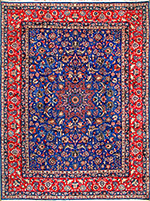Textiles Studies

Textile Research Works
Date of this Version
2004
Document Type
Article
Citation
Encyclopaedia Iranica
https://iranicaonline.org/articles/indigo
Abstract
INDIGO (Pers. nil), the common name of a broad genus, Indigofera, with numerous species, widely distributed throughout Asia, Africa, and the Americas. A member of the leguminous pea family, indigo is variously classified as an herb or small shrub; its stalks are long, bearing raceme flowers. It is usually perennial, but in some areas annual. Native species are known from Arabia, including the Yemen, and around the Indian Ocean. In some sources Persia is not listed among those regions in which indigo occurs in a natural form (e.g., the website mentioned below). Hans Wulff (p. 192) mentions two local species yielding indigo, grown near Bam in Baluchistan (Indigofera anil and Indigofera linifolia); Cecil Edwards (p. 32-33) mentions Kermān and Ḵuzestān but says that all indigo used for dyeing wool for rugs was imported. Many tribal groups in Persia have relied on the use of indigo to achieve a stable blue color for the wool of carpets and kilims. The quality of color assumes particular characteristics based upon local conditions and traditions for its use. Technical and stylistic features of rugs produced by Kurds, Šāhsevan, Qašqāʾi, Afšār, and those referred to as Baluch, include differences in the qualities of blue color, all derivative of indigo. Turkmen rugs tend to have less blue than those of other peoples. Commercially produced carpets from central Persia often utilize cotton wefts dyed blue using indigo, as well as indigo-dyed yarn for blue pile colors. A very dark blue, double-dyed, characterizes the carpets of Bijār, Karaja, and Karadag; a medium blue characterizes the urban production of carpets from Heriz (also those called Serape), whereas a lighter blue is typical of rugs from Isfahan and its surrounding region. A range of dark, medium, and light blues is documented among the classical carpets of Persia in the Safavid period. Broadloomed cotton flatweaves called zilu may also be dyed using indigo, including some early examples. Armenian flatweaves (from Azerbaijan, eastern Anatolia, and western India) in wool, silk, or cotton are often dyed using indigo as a ground color for warp and weft.
Included in
Art and Materials Conservation Commons, Art Practice Commons, Fiber, Textile, and Weaving Arts Commons, Indigenous Studies Commons, Museum Studies Commons


Comments
©2024 ENCYCLOPÆDIA IRANICA FOUNDATION, INC.